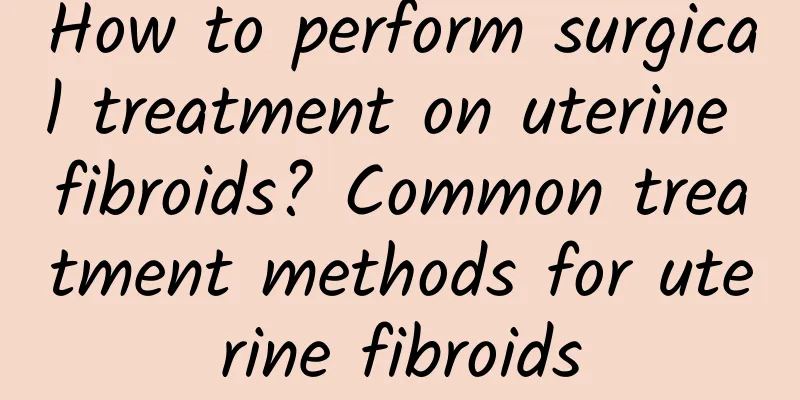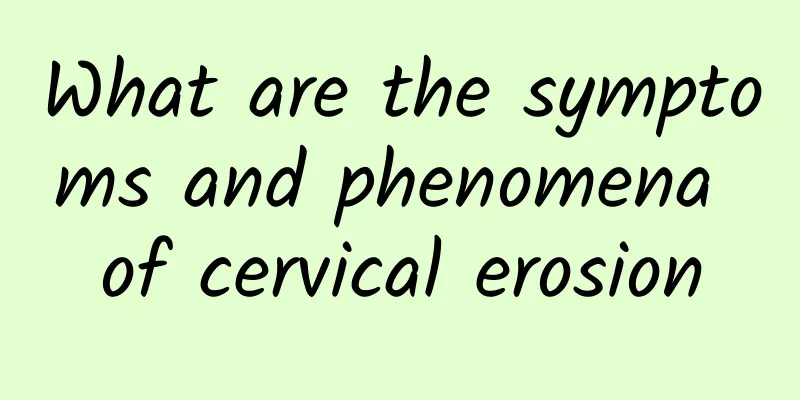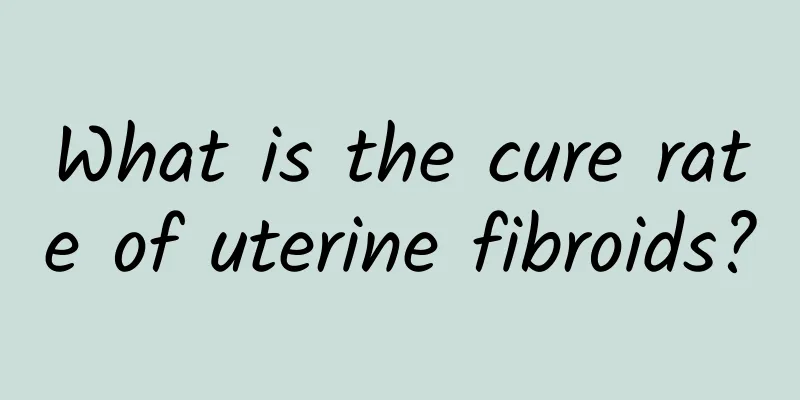How to perform surgical treatment on uterine fibroids? Common treatment methods for uterine fibroids

|
Uterine fibroids are the most common benign tumors in female genitals and one of the most common tumors in the human body. They are also called fibroids and uterine fibroids. Let's see how to treat uterine fibroids. Common treatments for uterine fibroids Surgical treatment: If long-term conservative treatment is ineffective, or if symptoms are obvious, the fibroids are large, anemic, and growing rapidly, treatment should be considered. 1) Myomectomy: Suitable for young patients who want to have children. Whether it is subserosal, intramural, or even submucosal, fibroids can be removed through the abdomen to preserve the uterus. Hysteroscopic minimally invasive myomectomy can be used for resection. 2) Hysterectomy: For older patients with uterine fibroids who have obvious symptoms and no desire to continue to have children, total hysterectomy, subtotal hysterectomy, and vaginal hysterectomy should be performed. At around 50 years old, one normal ovary can be retained to maintain endocrine function. Drug therapy: As a hormone-resistant tumor, the main treatment drugs for uterine fibroids include various anti-stimulant preparations to reduce tumors or inhibit tumor growth. Commonly used drugs are gonadotropin-releasing hormone agonists (GnRHa), mifepristone, oral contraceptives, progesterone, etc. Common routes and methods of administration include subcutaneous injection or oral administration, local vaginal administration, intrauterine device (levonorgestrel intrauterine releasing system) and interventional embolization. Diet therapy: Shugan Sanjie Decoction Source: Yin Huihe, famous doctor’s prescription Ingredients: 9 grams of bupleurum, 30 grams of raw oyster (fried first), salvia miltiorrhiza, red peony root, Scrophularia ningpoensis, angelica, selfheal, seaweed, kelp, pumice (fried first), 15 grams of Achyranthes bidentata, 3 grams of Fritillaria cirrhosa (ground and rinsed). Usage: Take 1 dose daily, decocted in water, twice a day. Function: Soothe the liver and relieve depression, promote blood circulation and remove blood stasis, soften and disperse stagnation. Explanation of the prescription: The above tumors are closely related to the circulation position and sensor of the liver and gallbladder meridians. Therefore, the method of soothing the liver and dispersing the knot is used to treat tumors such as uterine fibroids, so as to achieve the purpose of unblocking the meridians and blood circulation. In the prescription, Bupleurum chinense soothes the liver and relieves depression; Angelica sinensis, red peony root, and Salvia miltiorrhiza regulate blood stasis in the liver meridian; Achyranthes bidentata guides the medicine to descend; Oyster, pumice, Scrophularia ningpoensis, Fritillaria cirrhosa, Prunella vulgaris, seaweed, kelp, and soft dispersing knots. Combined with the effects of soothing the liver and dispersing knots. Main indications: This prescription can treat various tumor diseases such as uterine fibroids, breast tumors, thyroid tumors, etc. Add or subtract: For patients with sternal chondritis and breast hyperplasia, add 30 grams of dandelion; for thyroid tumors, add 10 grams of Platycodon and 3 Xiaojindan (3 times a day, 1 pill each time); for those who are irritable and sweaty, appropriately use Gardenia Sauce Soup; for women with menopausal uterine fibroids and menorrhagia, add 10 grams of Achyranthes bidentata, 15 grams of Zedoariae leaves, and 30 grams of Euphorbia milii; for cervical lymphadenitis, remove Achyranthes bidentata and add 9 grams of Platycodon and Citrus aurantium. Efficacy: Commonly used in clinical practice, with good results. Note: The author's clinical examination shows that it is effective, but more doses must be taken to start. 2. Juli Sanjie Pills Source: Luo Yuankai, New Chinese Medicine (8) 1990 Ingredients: tangerine seed, litchi seed, chuanxiong, fennel, lindera strychnifolia, neem, seaweed, rhizoma cyrtonema, truncatum, processed radix polygoni multiflori, codonopsis pilosula, oyster, chestnut shell, motherwort. Usage: Grind the medicine into fine powder, and make honey pills as big as sycamore. Take 3 times a day, 6 grams each time. Take it with boiled water when you are half hungry and half full. If the body is hot or hot, take it with light salt water. Start taking it 3 days after the menstruation is over, stop taking it 3 to 5 days before the menstruation, 1 course of treatment for 3 months, and observe 1 to 3 courses of treatment. Function: Promotes qi circulation and dissipates stagnation, softens, hardens and astringes the body, replenishes qi and activates blood circulation. Prescription explanation: The gynecological jade ruler says: "Women who suffer from this disease are generally due to fetal delivery, menstrual flow, blood and essence imbalance, improper diet, spleen and stomach deficiency, and evil qi invasion, which accumulates in the abdomen." However, although the cause is complicated, it is nothing more than the gathering of positive, virtual and evil, and the mixture of virtual and real. This prescription is made by adding and subtracting the orange core pills in the "Jisheng Fang" and the litchi powder in the "Jingyue Quanshu". After repeated clinical verification and revision. Litchi kernel, orange kernel, chestnut shell, fennel, neem, black medicine regulates qi and disperses knots, relieves pain and eliminates symptoms; Eshu qi breaks blood and attacks and removes stagnation; seaweed and oysters soften and disperse knots; Codonopsis pilosula replenishes qi, blood, and spleen; Chuanlian replenishes kidney and relaxes tendons; Shouwu and Ganggen replenish blood and stop bleeding (especially after menstruation); Motherwort can activate blood and regulate menstruation, promote blood circulation and remove blood stasis, and significantly enhance the contractility and tension of uterine muscles. In general, it can attack, protect, supplement attack, dissipate, disperse qi and disperse knots, soften and astringe, and replenish qi and activate blood. It does improve the body's ability to fight tumors, so the treatment is more effective. Main indications: uterine fibroids. How to care for uterine fibroids? 1. Maintain a good attitude: Although uterine fibroids are very harmful, they are difficult to treat. Therefore, after becoming ill, you need to maintain a good attitude. Generally, the tumor is not very large and can be treated in time without affecting the body. 2. Avoid taking estrogen drugs: Since uterine fibroids are a hormone-dependent disease, as long as you avoid taking hormone drugs and health care products for a long time and do not damage the endocrine system and cause hormone level disorder, you can effectively avoid the occurrence of uterine fibroids. 3. After being diagnosed with uterine fibroids, you should go to the hospital for regular check-ups. If the fibroids grow slowly or not at all, you can have a check-up every six months; if they grow significantly, you should consider surgical treatment to avoid severe bleeding or compression of abdominal organs. 4. Avoid getting pregnant again. Women with uterine fibroids may not recover well after an abortion, which often causes long-term bleeding or chronic genital inflammation. |
<<: What are the surgical treatments for uterine fibroids? The main treatments for uterine fibroids
Recommend
What should pregnant women do if they have uterine fibroids? Can you still give birth if you have uterine fibroids during pregnancy?
Pregnancy is a happy thing in a woman's life,...
Is obesity caused by “eating too little”? 5 types of body types: Fruit lovers, find out what nutrients they lack to lose weight
If someone is still trying thankless weight loss ...
Eat rice to supplement anthocyanins~ If you choose the wrong black rice or purple rice, be careful about your blood sugar getting out of control!
Anthocyanin diet is becoming popular, but are we ...
What should I do if I have irregular menstruation for a long time?
What should I do if I have irregular menstruation...
Experts explain the causes of female vulvar leukoplakia
Many people don't know what the female vulvar...
How to judge uterine prolapse and what to do
Uterine prolapse refers to a disease in which the...
How to take care of yourself after abortion surgery
Although abortion surgery is not very dangerous, ...
Will cervicitis affect fertility? 4 steps to treat and care for cervicitis in women
The uterus is particularly important to women. Du...
Does exercise make you younger? If you don't sleep well, you will age faster
[Key Points]: If you hope to make yourself look y...
What should I pay attention to when I have pelvic effusion?
What should we pay attention to in case of pelvic...
How to satisfy yourself during menstruation
During menstruation, satisfying yourself is not o...
4 hazards of vulvar leukoplakia
Vulvar leukoplakia is a common disease in menopau...
Do you know any prevention methods for ovarian cysts?
What are the prevention methods for ovarian cysts...
How to effectively prevent chronic cervicitis? Three things you must know about preventing chronic cervicitis
The cervical canal contains glandular cells that ...
What are the causes of dysmenorrhea?
Dysmenorrhea is a common phenomenon in life, and ...









